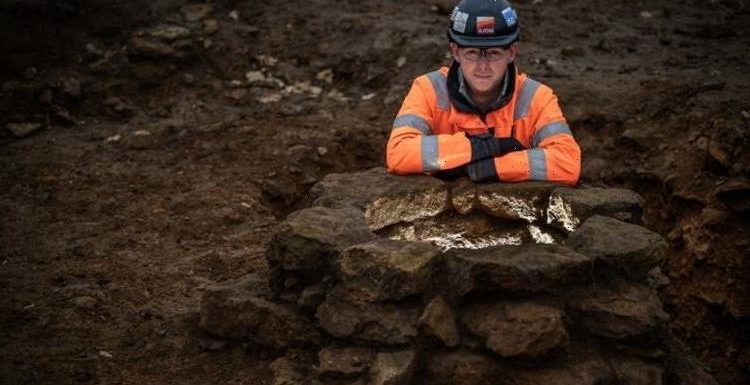
Digging for Britain: Excavation finds old Roman roads
We use your sign-up to provide content in ways you’ve consented to and to improve our understanding of you. This may include adverts from us and 3rd parties based on our understanding. You can unsubscribe at any time. More info
Around 300 Roman coins, glass vessels and water wells were unearthed in what is now the district of South Northamptonshire. The town was somewhat of an ancient hotspot, and is known as “Blackgrounds” for its black soil. The area has an abundance of ancient artefacts and structures spanning different time periods. These include depictions of deities and Roman game pieces.
Around 80 archaeologists from the Museum of London Archaeology (MOLA) Headland Infrastructure have spent the past year excavating the site ahead of the construction of HS2, a new high-speed railway.
James West, MOLA site manager, said: “What you would see is a whole hive of activity, people doing different things — people living, people working and people trading as well.”
Blackgrounds’ rich history has been known about since the 18th century.
But it was not until the HS2 survey and excavation that archaeologists discovered the shocking levels of the site’s preservation.
Thanks to the latest excavation, it was discovered the village had over 30 roundhouses sitting near a road during the Iron Age.


The settlement also became more prosperous and expanded over time.
And Blackgrounds people built new stone buildings and roads during the Roman period.
It is thought that the transition from Iron Age village to Roman town happened so quickly that it is likely Blackgrounds’ inhabitants stayed the same.
This meant they would have had to adapt to the rules and cultures of the Roman Empire — a process known as Romanization.
The archaeologists said this included changes like using Roman customs, products and building techniques.

New building techniques involved a 33-foot-wide (10 meters) Roman road.
Mr West said this was “exceptional in its size” as most Roman roads were no more than 13 feet (4 m) wide.
The road would likely have been filled with animals and people loading and unloading goods from carts.
This, as well as the nearby River Cherwell, helped to make Blackgrounds a thriving trade hub.
It was also discovered that the settlement was divided into different sections.
DON’T MISS
Archaeologists baffled by skeleton that had been ‘rolled into a ditch’ [REPORT]
Tourist spots under threat as mega iceberg leaks 152 tonnes of water [REVEAL]
Truss close to Brexit deal as UK to pump funds into EU project [INSIGHT]

These included a domestic sector filled with building foundations and an industrial park that had workshops, kilns and preserved wells.
Other artefacts indicative of Blackgrounds’ prosperity include Roman weaving accessories and decorative pottery.
Archaeologists also found a Roman snake head-shaped brooch.
And they found galena, a lead sulfide mineral that ancient Romans crushed and mixed with oil that would create an ancient makeup formula.

A set of shackles that are similar to those found in Great Casterton, a village in England’s East Midlands region, was also discovered.
MOLA’s statement claims the shackles were not discovered with a human burial, but suggest that Blackgrounds had either slave labour or criminal activity.
The archaeologists are now mapping out the Blackgrounds settlement.
And specialists at MOLA Headland Infrastructure are cleaning and examining the artefacts that were spotted at the site.
Source: Read Full Article